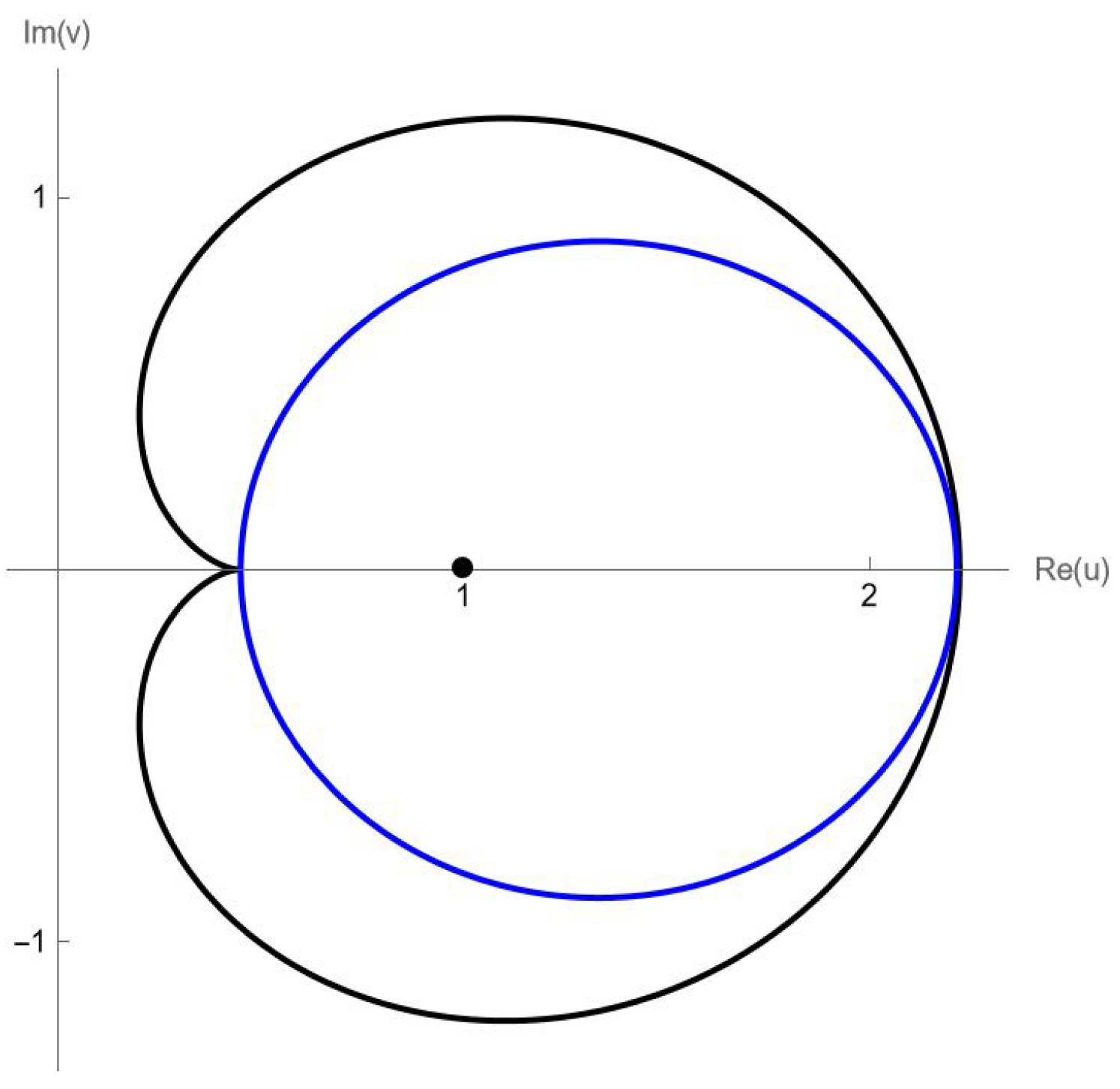Sharp Bounds on Hankel Determinants for Starlike Functions Defined by Symmetry with Respect to Symmetric Domains
Abstract
1. Introduction
2. Coefficient Bounds
3. Inequalities Involving Zalcman Functionals and Second Hankel Determinants
4. Second Hankel Determinants for Inverse Functions
5. Third Hankel Determinant for
6. Conclusions
Author Contributions
Funding
Data Availability Statement
Conflicts of Interest
References
- Shi, L.; Arif, M.; Abbas, M.; Ihsan, M. Sharp bounds of Hankel determinant for the inverse functions on a subclass of bounded turning functions. Mediterr. J. Math. 2023, 20, 156. [Google Scholar] [CrossRef]
- Tayyah, A.S.; Atshan, W.G. Starlikeness and bi-starlikeness associated with a new Carathéodory function. J. Math. Sci. 2025. [Google Scholar] [CrossRef]
- Prokhorov, D.V.; Szynal, J. Inverse coefficients for (α, β)-convex functions. Ann. Univ. Mariae Curie-Skłodowska Sect. A 1981, 35, 125–143. [Google Scholar]
- Efraimidis, I. A generalization of Livingston’s coefficient inequalities for functions with positive real part. J. Math. Anal. Appl. 2016, 435, 369–379. [Google Scholar] [CrossRef]
- Zaprawa, P. Initial logarithmic coefficients for functions starlike with respect to symmetric points. Bol. Soc. Mat. Mex. 2021, 27, 62. [Google Scholar] [CrossRef]
- Zaprawa, P.; Obradović, M.; Tuneski, N. Third Hankel determinant for univalent starlike functions. Rev. R. Acad. Cienc. Exactas Fís. Nat. Ser. A Mat. RACSAM 2021, 115, 49. [Google Scholar] [CrossRef]
- Zaprawa, P. On coefficient problems for functions starlike with respect to symmetric points. Bol. Soc. Mat. Mex. 2022, 28, 17. [Google Scholar] [CrossRef]
- Noonan, J.W.; Thomas, D.K. On the second Hankel determinant of areally mean p-valent functions. Trans. Am. Math. Soc. 1976, 223, 337–346. [Google Scholar] [CrossRef]
- Hayman, W.K. On second Hankel determinant of mean univalent functions. Proc. Lond. Math. Soc. 1968, 3, 77–94. [Google Scholar] [CrossRef]
- Janteng, A.; Halim, S.A.; Darus, M. Coefficient inequality for a function whose derivative has a positive real part. J. Inequal. Pure Appl. Math. 2006, 7, 50. [Google Scholar]
- Babalola, K.O. On H3(1) Hankel determinant for some classes of univalent functions. In Inequality Theory and Applications; Nova Science Publishers, Inc.: Hauppauge, NY, USA, 2010; Volume 6, pp. 1–7. [Google Scholar]
- Zaprawa, P. Third Hankel determinants for subclasses of univalent functions. Mediterr. J. Math. 2017, 14, 10. [Google Scholar] [CrossRef]
- Arif, M.; Marwa, S.; Xin, Q.; Tchier, F.; Ayaz, M.; Malik, S.N. Sharp coefficient problems of functions with bounded turning subordinated by sigmoid function. Mathematics 2022, 10, 3862. [Google Scholar] [CrossRef]
- Khan, M.G.; Ahmad, B.; Murugusundaramoorthy, G.; Chinram, R.; Mashwani, W.K. Applications of Modified Sigmoid Functions to a Class of Starlike Functions. J. Funct. Spaces 2020, 2020, 8844814. [Google Scholar] [CrossRef]
- Orhan, H.; Çağlar, M.; Cotirla, L.-I. Third Hankel determinant for a subfamily of holomorphic functions related with lemniscate of Bernoulli. Mathematics 2023, 11, 1147. [Google Scholar] [CrossRef]
- Shi, L.; Arif, M.; Rafiq, A.; Abbas, M.; Iqbal, J. Sharp bounds of Hankel determinant on logarithmic coefficients for functions of bounded turning associated with petal-shaped domain. Mathematics 2022, 10, 1939. [Google Scholar] [CrossRef]
- Riaz, A.; Raza, M.; Binyamin, M.A.; Saliu, A. The second and third Hankel determinants for starlike and convex functions associated with Three-Leaf function. Heliyon 2023, 9, 12748. [Google Scholar] [CrossRef]
- Bansal, D.; Maharana, S.; Prajapat, J.K. Third order Hankel determinant for certain univalent functions. J. Korean Math. Soc. 2015, 52, 1139–1148. [Google Scholar] [CrossRef]
- Krishna, D.V.; Venkateswarlu, B.; RamReddy, T. Third Hankel determinant for bounded turning functions of order alpha. J. Niger. Math. Soc. 2015, 34, 121–127. [Google Scholar] [CrossRef]
- Kwon, O.S.; Lecko, A.; Sim, Y.J. The bound of the Hankel determinant of the third kind for starlike functions. Bull. Malays. Math. Sci. Soc. 2019, 42, 767–780. [Google Scholar] [CrossRef]
- Kanas, S.; Răducanu, D. Some class of analytic functions related to conic domains. Math. Slovaca 2014, 64, 1183–1196. [Google Scholar] [CrossRef]
- Abd El-Hamid, H.A.H.; Rezk, M.; Ahmed, A.M.; AlNemer, G.; Zakarya, M.; El Saify, H.A. Dynamic Inequalities in Quotients with General Kernels and Measures. J. Funct. Spaces 2020, 2020, 5417084. [Google Scholar] [CrossRef]
- Ahmed, A.M.; Saker, S.H.; Kenawy, M.R.; Rezk, H.M. Lower Bounds on a Generalization of Cesaro Operator on Time Scales. Dyn. Contin. Discret. Impuls. Syst. Ser. A Math. Anal. 2021, 28, 345–355. [Google Scholar]


Disclaimer/Publisher’s Note: The statements, opinions and data contained in all publications are solely those of the individual author(s) and contributor(s) and not of MDPI and/or the editor(s). MDPI and/or the editor(s) disclaim responsibility for any injury to people or property resulting from any ideas, methods, instructions or products referred to in the content. |
© 2025 by the authors. Licensee MDPI, Basel, Switzerland. This article is an open access article distributed under the terms and conditions of the Creative Commons Attribution (CC BY) license (https://creativecommons.org/licenses/by/4.0/).
Share and Cite
Lupaş, A.A.; Tayyah, A.S.; Sokół, J. Sharp Bounds on Hankel Determinants for Starlike Functions Defined by Symmetry with Respect to Symmetric Domains. Symmetry 2025, 17, 1244. https://doi.org/10.3390/sym17081244
Lupaş AA, Tayyah AS, Sokół J. Sharp Bounds on Hankel Determinants for Starlike Functions Defined by Symmetry with Respect to Symmetric Domains. Symmetry. 2025; 17(8):1244. https://doi.org/10.3390/sym17081244
Chicago/Turabian StyleLupaş, Alina Alb, Adel Salim Tayyah, and Janusz Sokół. 2025. "Sharp Bounds on Hankel Determinants for Starlike Functions Defined by Symmetry with Respect to Symmetric Domains" Symmetry 17, no. 8: 1244. https://doi.org/10.3390/sym17081244
APA StyleLupaş, A. A., Tayyah, A. S., & Sokół, J. (2025). Sharp Bounds on Hankel Determinants for Starlike Functions Defined by Symmetry with Respect to Symmetric Domains. Symmetry, 17(8), 1244. https://doi.org/10.3390/sym17081244







